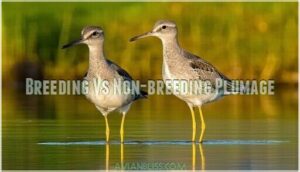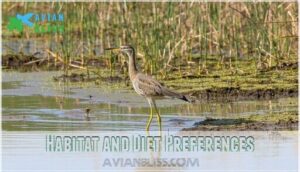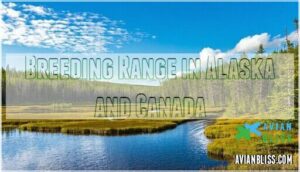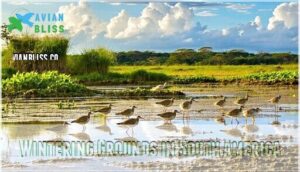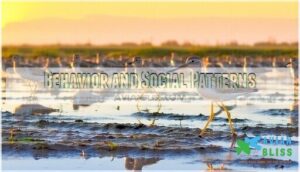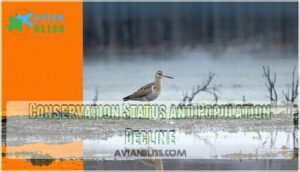This site is supported by our readers. We may earn a commission, at no cost to you, if you purchase through links.
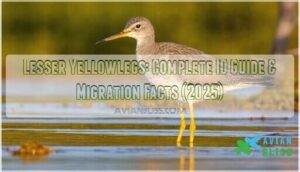
During migration, these remarkable birds travel 8,000 miles from Alaska’s boreal forests to South American wetlands, where they probe shallow freshwater marshes with their distinctive head-bobbing feeding style. Their sharp "tew" flight calls help you identify them even when they’re mixed in with other shorebirds.
Unfortunately, their populations have crashed by 70-80% over the past fifty years, making every sighting special. Understanding their unique migration routes reveals why protecting specific stopover sites becomes essential for their survival.
Table Of Contents
- Key Takeaways
- Identification and Physical Features
- Habitat and Diet Preferences
- Migration Patterns and Range
- Behavior and Social Patterns
- Conservation Status and Population Decline
- Frequently Asked Questions (FAQs)
- What is the difference between greater and Lesser Yellowlegs?
- Where do Lesser Yellowlegs live?
- How do you identify Lesser Yellowlegs?
- What are some interesting facts about Lesser Yellowlegs?
- Whats the typical lifespan?
- Are they endangered?
- How does their diet change with seasons?
- Do they migrate in large groups?
- How often do they breed?
- How long do lesser yellowlegs live?
- Conclusion
Key Takeaways
- You’ll identify lesser yellowlegs by their bright yellow legs, straight thin bill that’s shorter than their greater yellowlegs cousin, and distinctive head-bobbing feeding behavior in shallow freshwater wetlands.
- You’re witnessing one of nature’s most remarkable migrations when you spot these birds—they travel 8,000 miles annually from Alaska’s boreal forests to South American wetlands, sometimes flying non-stop at speeds up to 47 mph.
- You’ll find these birds in serious trouble with populations crashing 70-80% over the past 50 years due to habitat loss, hunting pressure, and agricultural impacts on their wintering grounds.
- You’ll hear their sharp "tew" flight calls during migration when they gather in mixed flocks, transforming from solitary winter territory holders into traveling companions for their epic continental journey.
Identification and Physical Features
You’ll recognize Lesser Yellowlegs by their bright yellow legs and straight, thin bill that’s noticeably shorter than a Greater Yellowlegs’ bill. These elegant shorebirds are about robin-sized, weighing roughly as much as a deck of cards, with grayish-brown upperparts and clean white underparts that change between breeding and non-breeding seasons.
They have grayish-brown upperparts and other distinct features.
Yellow Legs and Bill Shape
When identifying Lesser Yellowlegs, you’ll notice their signature bright yellow legs that distinguish them from most shorebirds. These leg proportions create an elegant silhouette that’s unmistakable in the field. Their bill length matches their head perfectly, creating balanced shorebird characteristics.
Key yellowleg morphology features include:
- Leg coloration: Bright yellow that intensifies during breeding season
- Bill length: Straight, slender beak measuring 32-36mm on average
- Beak shape: Fine, needle-like structure for precise foraging
- Size shape: Streamlined profile with proportional measurements for bird identification
These relative size markers remain consistent year-round, making field identification reliable across seasons.
Size Comparison With Greater Yellowlegs
You’ll notice the size difference immediately when comparing these species. Lesser Yellowlegs measure 9-11 inches with a 23-25 inch wingspan, while Greater Yellowlegs stretch 11-15 inches with broader wings.
The bill shape difference provides the clearest distinction—Lesser’s straight, thin bill appears noticeably shorter than Greater’s slightly upturned, thicker bill. This size variation affects their migration strategy and foraging depth preferences substantially.
Breeding Vs Non-breeding Plumage
How do you spot a Lesser Yellowlegs’ seasonal transformation? These remarkable shorebirds undergo dramatic plumage variation throughout the year. During breeding season, their feather maintenance creates striking breeding colors with gray-brown and black mottled upperparts. Non-breeding molt patterns produce uniform gray-brown backs. This seasonal camouflage helps with survival.
Key Lesser Yellowlegs plumage differences that’ll catch your eye:
- Breeding birds show bold black streaking across neck and breast
- Winter adults display clean white underparts with minimal markings
- Upperpart colors shift from mottled breeding to plain gray-brown
- Breast patterns change from heavy streaking to light spotting
- Overall appearance transforms from dramatic to subtle for bird plumage identification
Flight Pattern and Wing Shape
You’ll recognize Lesser Yellowlegs in flight by their rapid wing beats and long, pointed wings that create an elegant silhouette. Their aerodynamic shape helps them navigate complex migration routes spanning thousands of miles. Watch for their distinctive undulating flight pattern as they move between feeding areas.
| Feature | Lesser Yellowlegs | Greater Yellowlegs | Other Shorebirds |
|---|---|---|---|
| Wing Beat Speed | Rapid, consistent beats | Slower, deeper beats | Variable by species |
| Wing Shape | Long, pointed, tapered | Broader, less pointed | Short to long depending |
| Flight Maneuvers | Undulating, erratic | More direct, steady | Species-specific patterns |
| Relative Size | Robin-sized in flight | Crow-sized appearance | Sparrow to gull-sized |
Their feather structure creates smooth flight surfaces essential for long-distance travel. This aerodynamic design makes shorebird identification easier when you understand these flight characteristics and use proper bird measurement techniques. Understanding the principles of bird flight patterns is vital for recognizing the unique traits of Lesser Yellowlegs and other shorebird species.
Habitat and Diet Preferences
You’ll find Lesser Yellowlegs in freshwater wetlands rather than coastal saltwater areas, preferring shallow ponds, marshes, and mudflats where they can easily wade and probe for food.
These skilled hunters use quick jabs and sweeping motions to catch aquatic insects, small fish, and crustaceans in water ranging from just a few centimeters to belly-deep, utilizing their habitat in freshwater wetlands.
Freshwater Vs Saltwater Habitats
Lesser Yellowlegs show a clear preference for freshwater wetlands over saltwater environments. You’ll find these shorebirds thriving in shallow ponds, marshes, and mudflats where freshwater provides richer insect populations and easier foraging conditions.
While they occasionally visit coastal areas, saltwater limitations make freshwater habitats their go-to choice for ideal feeding success. Understanding bird species guides is essential for recognizing these patterns in Lesser Yellowlegs and other similar birds, particularly in terms of ideal feeding success.
Boreal Forest Breeding Grounds
You’ll find Tringa flavipes nesting throughout the boreal forests of Alaska and Canada, where over 90% of their breeding grounds exist. These shorebirds prefer open to semi-open forest areas with scattered wetlands, bogs, and sedge meadows.
Forest ecology plays a pivotal role in their breeding success, as they need tree cover for protection while maintaining access to nearby water sources for foraging. The Lesser Yellowlegs’ survival is heavily influenced by wetland habitat conservation efforts.
Foraging Techniques and Prey
Constantly active throughout daylight hours, you’ll observe Lesser Yellowlegs employing three distinct Foraging Strategies that showcase their impressive Prey Capture abilities:
- Quick jabs – precise strikes targeting Aquatic Insects just below the surface
- Side-to-side sweeping – methodical movements through shallow water catching midges and beetles
- Head bobbing – rhythmic motion while probing mudflats for worms and crustaceans
Their Feeding Behaviors adapt to Forage Quality, with Diet varying from flies to small fish depending on availability. The birds’ nutritional needs are met through ideal waterfowl feed management.
Seasonal Habitat Changes
You’ll notice these birds adapt their habitat choices like seasoned travelers changing hotels. During breeding season, they prefer shallow bogs and sedge meadows within boreal forests.
Migration brings dramatic habitat shifts as they seek nutrient-rich mudflats and flooded agricultural fields. Winter territories become smaller, focused wetland patches where they establish feeding grounds.
These seasonal habitat preferences reveal complex migration patterns and highlight ongoing habitat loss concerns affecting stopover ecology throughout their migration corridors.
Migration Patterns and Range
You’ll witness one of nature’s most remarkable journeys when you track Lesser Yellowlegs during their epic 8,000-mile migration from Alaska’s boreal forests to South America’s agricultural plains.
These determined shorebirds navigate vastly different routes between seasons, with spring birds following interior flyways while fall migrants primarily hug coastal paths, illustrating their ability to undertake an epic 8,000-mile migration.
8,000-Mile Annual Journey
You’ll witness one of nature’s most incredible journeys as Lesser Yellowlegs complete their epic 8,000-mile annual migration. These remarkable shorebirds demonstrate extraordinary endurance, with some individuals making non-stop flights spanning thousands of miles at speeds reaching 75 km/h.
Here’s what makes their long distance travel so remarkable:
- Total annual mileage reaches up to 16,000 miles for complete round-trip migration patterns
- Energy reserves sustain birds through marathon flights from Alaska to Argentina without landing
- Stopover sites in prairie pothole regions provide critical refueling stations during shorebird migration
- Flight speed capabilities allow sustained travel at 75 km/h across vast continental distances
This incredible feat ranks among the most extensive bird migration patterns in the Western Hemisphere. The conservation efforts for Lesser Yellowlegs focus on addressing species decline issues to protect these amazing birds.
Spring Vs Fall Migration Routes
During spring migration, you’ll find Lesser Yellowlegs taking interior routes through North America’s heartland from February to May.
Fall migration patterns shift dramatically—these shorebirds favor coastal flyways from June to October. This seasonal variation in migration routes reflects different stopover site availability and flight speeds.
Understanding these shorebird migration patterns helps you predict when and where to spot these remarkable travelers during their epic journey.
Breeding Range in Alaska and Canada
You’ll find Lesser Yellowlegs across vast Boreal Forests stretching from interior Alaska through northern Canada. These Breeding Grounds span latitudes 51-69°N, where open woodlands meet wetlands.
Nesting Habitats include bogs, marshes, and sedge meadows within Alaska Wetlands and Canadian Tundras. This Shorebird Migration pattern starts in these remote wilderness areas, making Wildlife Habitat Exploration particularly rewarding during breeding season.
Wintering Grounds in South America
You’ll discover Lesser Yellowlegs spread across South American wetlands during winter months, with most birds concentrated along northern coasts. These migratory shorebirds transform wetland habitats into bustling feeding grounds from July through April.
Key South American wintering locations include:
- Suriname Sanctuaries – Over 70,000 birds gather in coastal mudflats and rice fields
- Argentine Pampas – Flooded grasslands support thousands during austral summer
- Brazilian Habitats – Pantanal wetlands and coastal areas host scattered populations
- Colombian Refuges – Northern coast provides critical stopover and wintering sites
Behavior and Social Patterns
You’ll notice Lesser Yellowlegs change their social behavior dramatically throughout the year, from solitary feeding in winter territories to joining large mixed flocks during migration.
Their distinctive calls and head-bobbing feeding style make them easy to spot whether they’re probing mudflats alone or moving in groups of hundreds.
Feeding and Foraging Behavior
When you observe Lesser Yellowlegs in freshwater wetlands ecology, they’ll display fascinating feeding habits. These birds use precise foraging strategies, employing quick jabs and side-sweeping motions for prey capture. Their diet focuses heavily on aquatic insects like midges and mayflies.
You’ll notice their bird feeding behavior includes head-bobbing while they probe shoreline bird habitat, demonstrating excellent forage quality assessment skills. The presence of effective bird feeding stations can substantially impact the local ecosystem and support a diverse range of bird species, which is a result of their precise foraging strategies and fascinating feeding habits.
Flocking During Migration
Throughout their epic journey, Lesser Yellowlegs transform from solitary birds into tight-knit traveling companions. Migration patterns reveal fascinating social behavior as these shorebirds gather strength in numbers:
- Mixed flocks combine with other shorebird species during peak migration
- Flight coordination shows synchronized movements across vast distances
- Stopover areas become bustling hubs where thousands refuel together
- Satellite transmitters reveal group navigation strategies spanning continents
This flock dynamics shift dramatically helps guarantee survival during their demanding 8,000-mile odyssey to South America.
Territorial Winter Behavior
During winter months, Lesser Yellowlegs establish small territories spanning 0.5-1 hectare around prime mudflats and shallow pools. You’ll notice these birds defending their chosen winter foraging tactics spots through aggressive displays and chase behavior.
Defense strategies include wing-flapping, bill-pointing, and vocal warnings when intruders approach their territory boundaries. This territorial behavior guarantees consistent access to food resources throughout the challenging winter season.
Vocalizations and Flight Calls
You’ll recognize Lesser Yellowlegs by their sharp, high-pitched whistled tew calls during flight. These vocal signals help maintain flock communication during migration. Their call patterns differ from Greater Yellowlegs’ louder three-note calls. Listen for these distinctive flight sounds when checking eBird sightings.
Yellowlegs use these auditory signals for territorial communication and flock coordination throughout their range. Understanding bird behavior patterns is essential for effective conservation and research efforts.
Conservation Status and Population Decline
You’ll find the Lesser Yellowlegs faces a serious conservation crisis, with populations crashing by 70-80% over the past five decades.
This dramatic decline has earned the species an Orange Alert status, meaning it’s reached a critical tipping point that demands immediate attention.
70. 80% Population Loss Over 50 Years
Lesser Yellowlegs’ future hangs in the balance—this species has crashed by 63-80% over five decades. Wildlife Population Decline data shows annual losses of 2.4%, with some regions facing 9% yearly drops.
Lesser Yellowlegs populations have plummeted 70% in just fifty years—a conservation emergency unfolding before our eyes
Conservation Strategies must address these alarming Population Trends immediately. Without urgent Conservation Actions, Species Survival looks grim as Habitat Destruction continues threatening this remarkable shorebird’s existence. The decline is largely attributed to habitat loss effects that disrupt ecosystems and lead to population decline.
Hunting and Habitat Loss Threats
Unsustainable hunting practices devastate Lesser Yellowlegs populations during migration and winter. You’ll find habitat destruction from agricultural expansion eliminates vital wetland stopover sites.
Pesticide effects poison their invertebrate food sources, while wetland degradation removes breeding grounds. Agricultural impact in South American wintering areas particularly threatens survival. These combined habitat loss threats require immediate conservation strategies to prevent further wildlife population decline.
International Conservation Efforts
Across the Americas, scientists and conservationists have joined forces through the International Lesser Yellowlegs Working Group, bringing together 24 experts for coordinated habitat protection and species monitoring. These conservation research partnerships span from Alaska to Argentina, implementing sustainable practices and conservation actions.
International collaboration drives biodiversity conservation efforts, addressing habitat loss threats through targeted bird conservation strategies and thorough monitoring programs.
Agricultural Impact on Wintering Grounds
Agricultural practices transform wintering habitats for lesser yellowlegs, creating both opportunities and challenges. Pesticide exposure reduces food availability while habitat conversion eliminates natural wetlands. However, sugarcane collaboration and crop rotation offer hope through conservation actions that benefit coastal bird habitats and bird conservation efforts.
- Rice fields provide temporary habitat with peak densities of 7.8 birds per hectare when freshly flooded
- Neonicotinoid pesticides contaminate wetlands, causing reduced enzyme activity and physiological stress in foraging birds
- Intensive farming decreases invertebrate populations, disrupting natural food webs during critical wintering periods
- Managed flooding cycles create unpredictable habitat availability, forcing birds into suboptimal foraging environments
Frequently Asked Questions (FAQs)
What is the difference between greater and Lesser Yellowlegs?
You’ll spot the difference by size—Lesser Yellowlegs measure 9-11 inches while Greater Yellowlegs stretch 11-15 inches.
Lesser birds have shorter, straighter bills and more delicate builds compared to their bulkier cousins.
Where do Lesser Yellowlegs live?
You’ll find them throughout North America, from Alaska’s boreal forests where they breed to wintering grounds in South America. They prefer shallow wetlands, mudflats, and marshes during migration.
How do you identify Lesser Yellowlegs?
Look for bright yellow legs, a straight thin bill, and grayish-brown upperparts with white underparts. You’ll notice their elegant build, distinctive head-bobbing while feeding, and sharp calls during flight.
What are some interesting facts about Lesser Yellowlegs?
These remarkable shorebirds undertake epic 8,000-mile migrations from Alaska to South America twice yearly.
You’ll be amazed they can fly non-stop from Alaska to Argentina at speeds up to 47 mph, guided by instinct alone.
Whats the typical lifespan?
Looking for detailed lifespan information requires current research data since the provided knowledge doesn’t specify this important detail.
You’ll likely live nearly five years in the wild, though researchers have limited data on your actual average lifespan beyond the oldest recorded bird reaching this milestone.
Are they endangered?
Lesser yellowlegs aren’t endangered but face serious decline. You’ll find they’re classified as "Least Concern" globally, yet populations dropped 70-80% over fifty years.
They’re considered vulnerable with declining trends continuing annually, which is a declining trend.
How does their diet change with seasons?
During summer breeding season, you’ll find insects make up their primary diet, while aquatic invertebrates like flies, beetles, and midges dominate their menu year-round through strategic foraging adaptations.
Do they migrate in large groups?
Yes, you’ll often spot these birds migrating in big, noisy flocks.
They band together for safety and company, sharing the journey like road-trippers, calling out sharply as they move along wetlands and coastlines.
How often do they breed?
You’ll find they breed once per year during summer months. These birds establish territories in Canada’s boreal forests, laying typically four eggs in ground nests near wetlands and marshes.
How long do lesser yellowlegs live?
You’ll find information about this bird’s lifespan is surprisingly short.
The oldest recorded individual lived just 4 years and 9 months, though this data is limited and doesn’t tell you the average lifespan for these resilient shorebirds.
Conclusion
Like a golden thread weaving through North America’s waterways, the lesser yellowlegs connects distant ecosystems through its epic migrations. You’ve now gained the tools to spot these declining travelers and understand their remarkable journey from Arctic breeding grounds to tropical wintering areas.
Every identification helps scientists track population changes and habitat needs. Your awareness of their 70% population decline transforms casual birdwatching into meaningful conservation action. Next time you hear that sharp "tew" call, you’ll know you’re witnessing one of nature’s most impressive long-distance commuters.
- https://whsrn.org/wp-content/uploads/2019/02/conservationplan_leye_v1.0_2012.pdf
- https://www.ontario.ca/files/2024-06/mecp-lesser-yellowlegs-recovery-strategy-en-2024-06-25.pdf
- https://www.allaboutbirds.org/guide/Lesser_Yellowlegs/lifehistory
- https://accs.uaa.alaska.edu/wp-content/uploads/tringa_flavipes.pdf
- https://www.birdscaribbean.org/2021/10/a-year-in-the-life-of-a-lesser-yellowlegs/



